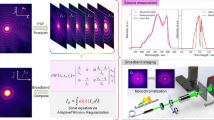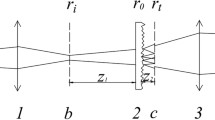Abstract
The denoising capabilities of the H-matrix and cyclic S-matrix based on the sparse reconstruction, employed in the Pixel of Focal Plane Coded Visible Spectrometer for spectrum measurement are investigated, where the spectrum is sparse in a known basis. In the measurement process, the digital micromirror device plays an important role, which implements the Hadamard coding. In contrast with Hadamard transform spectrometry, based on the shift invariability, this spectrometer may have the advantage of a high efficiency. Simulations and experiments show that the nonlinear solution with a sparse reconstruction has a better signal-to-noise ratio than the linear solution and the H-matrix outperforms the cyclic S-matrix whether the reconstruction method is nonlinear or linear.







Similar content being viewed by others
References
W.J. Moses, J.H. Bowles, R.L. Lucke, M.R. Corson, Impact of signal-to-noise ratio in a hyperspectral sensor on the accuracy of biophysical parameter estimation in case II waters. Opt. Express 20(4), 4309–4330 (2012)
A.A. Wagadarikar, M.E. Gehm, D.J. Brady, Performance comparison of aperture codes for multimodal, multiplex spectroscopy. Appl. Opt. 46(22), 4932–4942 (2007)
B.H. Clowers, W.F. Siems, H.H. Hill, S.M. Massick, Hadamard transform ion mobility spectrometry. Anal. Chem. 78(13), 44–51 (2006)
D.C. Tilotta, R.M. Hammaker, W.G. Fateley, Multiplex advantage in Hadamard transform spectrometry utilizing solid-state encoding masks with uniform, bistable optical transmission defects. Appl. Opt. 26(19), 4285–4292 (1987)
A. Wuttig, Optimal transformations for optical multiplex measurements in the presence of photon noise. Appl. Opt. 44, 2710–2719 (2005)
M. Harwit, N.J.A. Sloane, Hadamard transform optics (Academic Press, New York, 1979)
J. Yue, J. Han, Y. Zhang, L. Bai, Denoising analysis of Hadamard transform spectrometry. Opt. Lett. 39(13), 3744–3747 (2014)
S.B. Mende, E.S. Claflin, R.L. Rairden, G.R. Swenson, Hadamard spectroscopy with a two-dimensional detecting array. Appl. Opt. 32(34), 7095–7105 (1993)
M. Mishali, Y.C. Eldar, From theory topractice: sub-Nyquist sampling of sparse wideband analog signals. IEEE J. Sel. Top. Process. 4(2), 375–391 (2010)
J.A. Tropp, Greed is good: algorithmic results for sparse approximation. IEEE Trans. Inf. Theory 50(10), 2231–2242 (2004)
Y. Shechtman, S. Gazit, A. Szameit, Y.C. Eldar, M. Segev, Super-resolution and reconstruction of sparse images carried by incoherent light. Opt. Lett. 35(8), 1148–1150 (2010)
A. Mrozack, D.L. Marks, D.J. Brady, Coded aperture spectroscopy with denoising through sparsity. Opt. Express 20(3), 2297–2309 (2012)
L. Streeter, G.R. Burling-Claridge, M.J. Cree, R. Künnemeyer, Optical full Hadamard matrix multiplexing and noise effects. Appl. Opt. 48(11), 2078–2085 (2009)
F. Soldevila, E. Irles, V. Durán, P. Clemente et al., Single-pixel polarimetric imaging spectrometer by compressive sensing. Appl. Phys. B 113, 551–558 (2013)
J. Yue, J. Han, L. Li, L. Bai, Denoising analysis of spatial pixel multiplex coded spectrometer with Hadamard H-matrix. Opt. Commun. 407, 355–360 (2018). https://doi.org/10.1016/j.optcom.2017.09.072
T.T. Cai, L. Wang, Orthogonal matching pursuit for sparse signal recovery with noise. IEEE Trans. Inf. Theory 57(7), 4680–4688 (2011)
D. Needell, J.A. Tropp, CoSaMP: iterative signal recovery from incomplete and inaccurate samples. Commun. ACM 53(12), 93–100 (2010)
J. Yue, J. Han, Y. Zhang, L. Bai, High-throughput deconvolution-resolved computational spectrometer. Chin. Opt. Lett. 12(4), 043001 (2014)
Acknowledgements
This work was supported by the National Natural Science Foundation of China (Grant no. 61601225), the Natural Science Foundation of Jiangsu Province (Grant no. BK20151482) and the Fundamental Research Funds for the Central Universities (30915011335). We acknowledge the advice from and discussions with Professor Wenquan Che, Department of Communication Engineering, Nanjing University of Science and Technology.
Author information
Authors and Affiliations
Corresponding author
Rights and permissions
About this article
Cite this article
Wang, Z., Yue, J., Han, J. et al. High-SNR spectrum measurement based on Hadamard encoding and sparse reconstruction. Appl. Phys. B 123, 277 (2017). https://doi.org/10.1007/s00340-017-6854-0
Received:
Accepted:
Published:
DOI: https://doi.org/10.1007/s00340-017-6854-0




